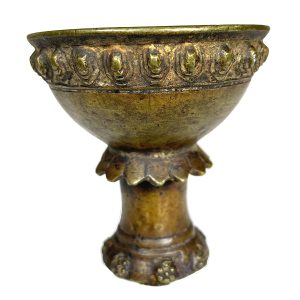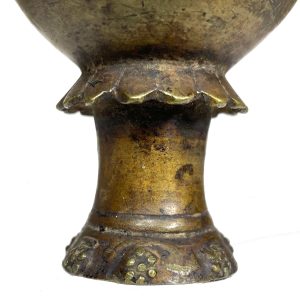Antique Kumkum Container, Nepal (1278XAE) $295
$295.00A kumkum container, also known as a sindor box is a small decorative holder for kumkum powder, a red or orange-red powder traditionally used in Hindu rituals and ceremonies. This container is brass with a foot with lotus leaves on the sides and floral patterns on the bottom and a decorative rim on the cup. These boxes are part of daily prayers (puja), festivals, weddings, and other auspicious occasions. The powder is used to apply a bindi – a forehead dot decoration associated with the third eye, representing wisdom and insight. While traditionally worn by women, and often signifying marriage, bindis are increasingly worn by men as well.
Antique bronze kumkum container use to hold tika power applied to women’s forehead during puja to preserve spiritual energy. andhold is as part of Hindu puja used for Hindu social and religious markings. Kumkum is dried and made into a paste combined with small amounts of slaked lime sometimes embellished with a few grains of rice that turns the turmeric reddish and is used to apply a tikka – a small dot applied on the forehead between the eyebrows. This spot is said to be the focal point of wisdom and concentration and is where the spiritual third eye is centered. Hindu’s believe this is the sixth of the body’s seven chakras or energy vortexes where an energy channel opens humans up to the spiritual and the divine. The tikka is said to prevent energy loss, preserve spiritual energy, and enhance concentration. Hindu religious gatherings and puja begin with the application of a tikka. Women from certain Hindu sects wear a tikka as a sign they are married,


